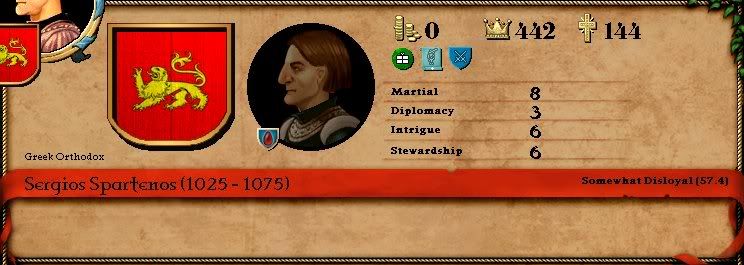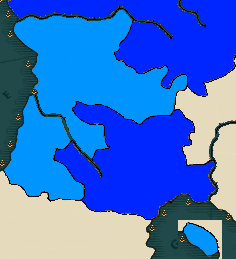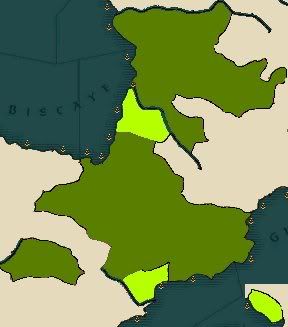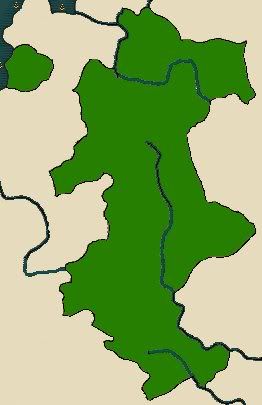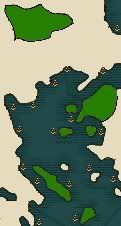Count Sergios Spartenos
Count of Napoli
In early 1066, I looked upon the Count and became greatly worried about his lack of a wife and only having one heir. By late 1066, I had found a suitable wife for the Count but the chances that her father would accept were small as far as I had seen it. I offer marriage to the King of Georgia, asking for the hand of his young daughter, Mariam Bagratuni. Less than two weeks later I received notice that the Georgian King had accepted my offer to marry his daughter to Count Sergios; much to not only my surprise but to the surprise of Count Sergios, himself.
The Count’s attentions now turned to his young son who was in need of a wife, I ensured him that I had already picked out a young woman of good standing for him to marry but he must wait 2 years for her to come of age. Her name was Agnes D’Aquitaine, the only child of the aging Duke of Aquitaine. With this section of his life on hold for the next two years, Count Sergios turned all of his attentions to his new wife, Mariam.
For the next two years, the County was quite, no wars were waged and no changes to the royal family made either. That was until Agnes D’Aquitaine turned 16 years old, quickly the Count under my advisement moved to offer marriage to her father, the Duke of Aquitaine. After a small show of force by me, he agreed to the marriage and soon, Marshal Sergios and Agnes D’Aquitaine were declared husband and wife.
Only 9 months later, the court was abuzz with excitement as two new members of the family were brought into the world, Eudoxia, the daughter of Count Sergios and Mariam, and Isaakios, the son of Marshal Sergios and Agnes. Isaakios was immediately declared the heir to the Duchy of Aquitaine. Another two years past as the court remained quite again; during which time Count Sergios began to look south to the County of Salerno with hungry eyes. The county remained too weak to effectively launch any assault against Salerno, so for the time being Sergios focused on his family and growing his dynasty and grow it he did. In 1070, another two members were added to the family in the form of Georgios, the son of Count Sergios and Mariam, who was in the line of succession for the Kingdom of Georgia by his mother; in the same year Marshal Sergios had a daughter named Theophano.
On November 19, 1071, word reached Agnes and her son Isaakios that Duke Guillaume had died at the age of 46 years old, and Isaakios became Prince Isaakios, Prince of Aquitaine, Gascony, and Poitou and Count of Agen, Bordeaux, Poitiers, and Saintonge. Later that same month, Count Sergios pledged fealty to his grandson for the protection it could provide against the growing threat of the Duchy of Apulia.
In June of 1072, Count Sergios had another child named Maria, and then in May of 1073, Marshal Sergios had another son, Romanos. In mid-1074, I received terrible news from France, Prince Isaakios had been forced undertake a Catholic mass and subsequently converted to Catholic, this angered count Sergios greatly. He told me to immediately begin searching for a way to “fix” this problem as he saw any member of his family being Catholic as a direct attack against his dynasty. While I was searching for an easy way to fix this issue, in March, Count Sergios also had a daughter named Theophano. By July of 1074, Count Sergios, my old friend, could feel his life coming to an end and asked me to prepare a legitimate claim for him to the throne of Navarra, a claim he knew he, himself, could not see to the end but that his son would have to, a way to get out from underneath a Catholic King.
On the first of December 1074, Count Sergios and Mariam were expecting another child, a child the Count would never meet. On March 3, 1074 Count Sergios and Spymaster Sergios received word that Isaakios had died at the tender age of six years old; this made his father Prince Sergios, Prince of Aquitaine, Gascony, and Poitou. Not long after this appointment with the weight of the years bearing down on him, I made one final meeting with Count Sergios Spartenos in the Garden of Napoli at midnight. This time was different, he was not alone and with him came his son and heir Prince Sergios. This is the dialogue to the best of my recollection:
“Son,” The Count said, “There is someone I would like you to meet, he has advised me for the last 15 years in secret and now he will be your advisor for the rest of your life.”
I came out of the shadows and the Prince gasped in surprise as was normal, and then I spoke, “Hello, my name is Romulios Constanellos, I have advised mighty men like Constantine, the Emperor of Rome and Charlemagne, the first Holy Roman Emperor. Now I shall advise you. You may ask me anything you wish.”
He stared for a moment then spoke. “How old are you? And do you know what happened to my child?”
I looked at the young Prince, I knew both answers, the first would be easier for him to except. “I am 1,000 years old.” I sighed and looked at the ground, “I am what happened to Isaakios.”
“I will accept your help, but you must follow my orders as you did my fathers.” He boldly proclaimed
“I was your father’s equal, we will have the same relationship or I will not help you.” I responded and with that I left.
On May 25, 1075, Count Sergios’ fear of dying came true when at the age of 50 he passed peacefully in his sleep. The next day I would depart Napoli for the South of France, I would not see the city for many more years.
Areas under Spartenos control as of May 25, 1075. Light Blue is Spartenos lands, darker Blue is Kingdom of France.


